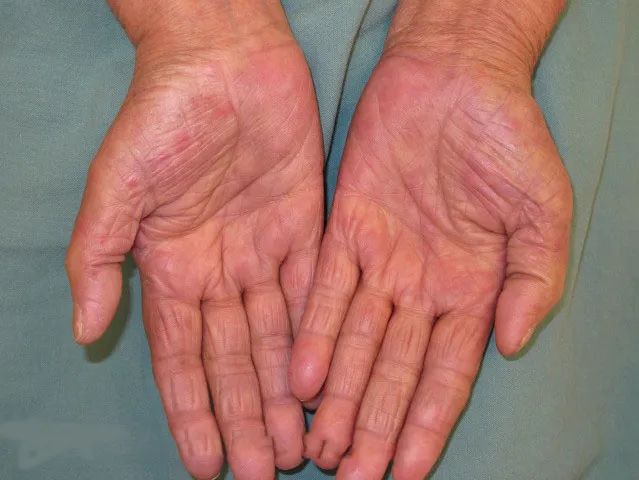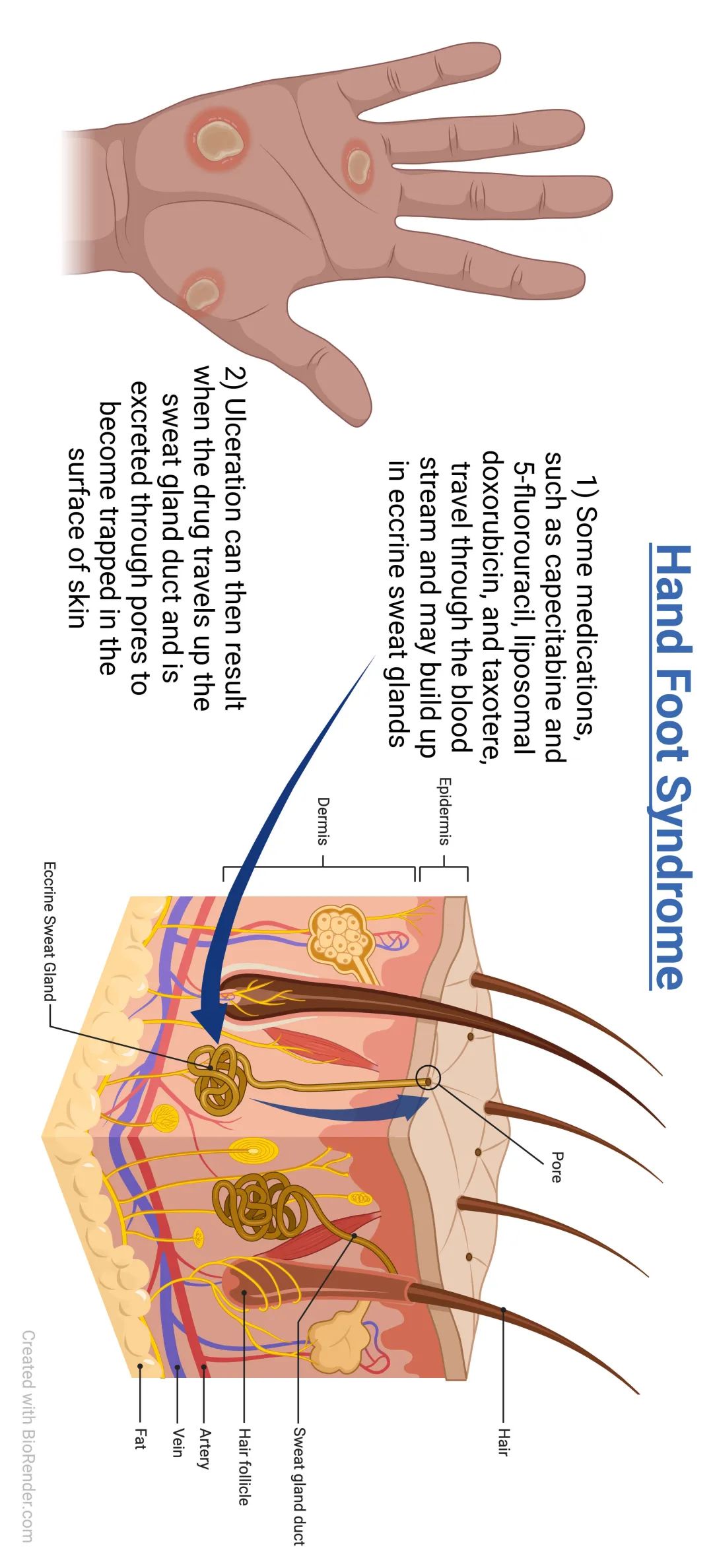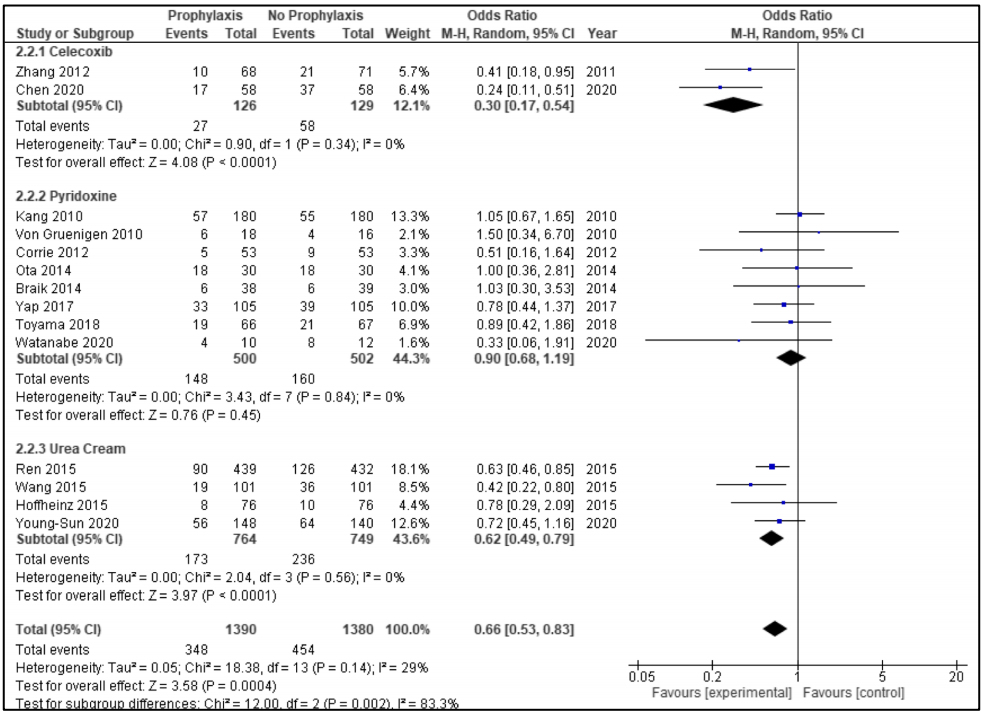1. Research Background
With the development of medical technology, anti-cancer treatment has achieved remarkable results, enabling patients to enjoy a longer survival time and a better quality of life. However, with the increase of treatment options, the toxicity of related treatments has become more and more serious. Hand-Foot Syndrome (HFS), also known as palmoplantar red blood cell sensory dysfunction, is a common, dose-dependent adverse reaction. It is usually caused by certain chemotherapy drugs, manifested as symptoms such as redness, swelling, obvious discomfort, swelling and tingling on the palms or soles of patients (see Figure 1, Figure 2). It has been reported since 1974 and has been recognized as an adverse reaction , which improves rapidly after stopping treatment.
The incidence of HFS is related to the drugs used, and the highest incidence has been reported in patients taking capecitabine and pegylated liposome-encapsulated doxorubicin. Other anthracyclines, taxanes, pyrimidine analogs, and 5-FU derivatives can also cause common side effects such as HFS. Currently, there is still no clear consensus on the use of these agents to prevent HFS. Therefore, this literature aims to perform a meta-analysis of randomized controlled trials of strategies for the prevention of HFS to provide strong evidence for forming recommendations for the prevention of HFS induced by systemic cancer therapy.


2. Research Methods
Eligible studies were identified using date restrictions through systematic literature searches of databases such as PubMed, Embase, Cochrane, and clinical trial registries. A thorough handsearch of reference lists of other relevant studies was also performed. Pooled effect sizes were calculated using the random-effects inverse variance method. A total of 222 articles were retrieved for evaluation, and a meta-analysis was performed on 2814 patients from 16 articles according to the described inclusion and exclusion criteria.
3. Research results
Two subgroup analyzes were performed according to the prophylaxis strategy patients received. The effectiveness of celecoxib in preventing HFS and the effectiveness of urea cream in preventing HFS and low dose (<200mg) vs high dose (>200mg) in capecitabine-based versus sorafenib therapy Subgroup analysis of pyridoxine for prevention of all grades of HFS (see Figure 3).

4. Research conclusion
Hand-foot syndrome remains one of the most common adverse side effects of modern systemic cancer treatment regimens. If not prevented or managed early, this can lead to serious adverse effects, changes in treatment plans, decreased quality of life, and affect the patient's survival time. Once it occurs, the recommended main treatment is to relieve symptoms by reducing the dose of chemotherapy drugs or stopping the drugs, which is undoubtedly harmful to the treatment, especially when capecitabine and sorafenib have good therapeutic effects. Prevention of HFS is an extremely important step, however, so far, no strategies have been proven to be effective. Currently, the use of pyridoxine, celecoxib, and urea cream is the most widely studied treatment strategy for HFS, and it is hoped that follow-up clinical rehabilitation experts can develop non-drug preventive measures.
With the development of medical technology, anti-cancer treatment has achieved remarkable results, enabling patients to enjoy a longer survival time and a better quality of life. However, with the increase of treatment options, the toxicity of related treatments has become more and more serious. Hand-Foot Syndrome (HFS), also known as palmoplantar red blood cell sensory dysfunction, is a common, dose-dependent adverse reaction. It is usually caused by certain chemotherapy drugs, manifested as symptoms such as redness, swelling, obvious discomfort, swelling and tingling on the palms or soles of patients (see Figure 1, Figure 2). It has been reported since 1974 and has been recognized as an adverse reaction , which improves rapidly after stopping treatment.
The incidence of HFS is related to the drugs used, and the highest incidence has been reported in patients taking capecitabine and pegylated liposome-encapsulated doxorubicin. Other anthracyclines, taxanes, pyrimidine analogs, and 5-FU derivatives can also cause common side effects such as HFS. Currently, there is still no clear consensus on the use of these agents to prevent HFS. Therefore, this literature aims to perform a meta-analysis of randomized controlled trials of strategies for the prevention of HFS to provide strong evidence for forming recommendations for the prevention of HFS induced by systemic cancer therapy.
2. Research Methods
Eligible studies were identified using date restrictions through systematic literature searches of databases such as PubMed, Embase, Cochrane, and clinical trial registries. A thorough handsearch of reference lists of other relevant studies was also performed. Pooled effect sizes were calculated using the random-effects inverse variance method. A total of 222 articles were retrieved for evaluation, and a meta-analysis was performed on 2814 patients from 16 articles according to the described inclusion and exclusion criteria.
3. Research results
Two subgroup analyzes were performed according to the prophylaxis strategy patients received. The effectiveness of celecoxib in preventing HFS and the effectiveness of urea cream in preventing HFS and low dose (<200mg) vs high dose (>200mg) in capecitabine-based versus sorafenib therapy Subgroup analysis of pyridoxine for prevention of all grades of HFS (see Figure 3).
4. Research conclusion
Hand-foot syndrome remains one of the most common adverse side effects of modern systemic cancer treatment regimens. If not prevented or managed early, this can lead to serious adverse effects, changes in treatment plans, decreased quality of life, and affect the patient's survival time. Once it occurs, the recommended main treatment is to relieve symptoms by reducing the dose of chemotherapy drugs or stopping the drugs, which is undoubtedly harmful to the treatment, especially when capecitabine and sorafenib have good therapeutic effects. Prevention of HFS is an extremely important step, however, so far, no strategies have been proven to be effective. Currently, the use of pyridoxine, celecoxib, and urea cream is the most widely studied treatment strategy for HFS, and it is hoped that follow-up clinical rehabilitation experts can develop non-drug preventive measures.



